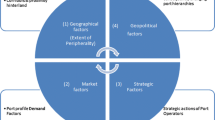Abstract
The growth of peripheral ports to dominant hubs has been well documented in North America and Europe, and has led to the elaboration of several theoretical models. However, although changes in containerization growth have been taking place in the South and East Asia in recent years, particularly in China, only a few studies have focused on this region. The Pearl (Zhujiang) River Delta (PRD) has a typical port system with hub and peripheral ports, and provides an excellent case for studying the Peripheral Challenge. This paper introduces the theoretical evidence of the Hayuth model and analyzes the evolution of the container port system in the PRD with five phases: 1) phase I: preconditions for change and phase II: initial container port development in the 1970s and early 1980s; 2) phase III: diffusion, consolidation, and port concentration in the middle and late 1980s; 3) phase IV: the load center in the 1990s; and (4) phase V: the Peripheral Challenge since the late 1990s. The results illustrate that the Shenzhen port presents mounting challenges to the Hong Kong port, descending from a transshipment hub of China to a regional load center of Southeast China. Furthermore, this paper explores five points that have led to the evolution of the port system in the PRD: 1) competition in the regional port systems; 2) different interested parties; 3) shift of investment strategies of international terminal operators; 4) integration of shipping networks and reorganization of carriers; and 5) cost-based competition.
Similar content being viewed by others
References
Airriess C A, 1989. The spatial spread of container transport in a developing regional economy. Transportation Research, (23): 453–461.
Baird A J, 1997. Rejoinder: Extending the lifecycle of container main ports in upstream urban locations. Maritime Policy & Management, 24(2): 299–301.
Cao Youhui, 1999. On the evolution model of container port system: A case study of the lower Changjiang River container port system. Scientia Geographica Sinica, 19(6): 485–490. (in Chinese)
Cao Youhui, Cao Weidong, 2003. Formation and evolution mechanism of coastal container ports system in China. Acta Geographica Sinica, 58(3): 424–432. (in Chinese)
Cao Youhui, Li Haijian, Chen Wen, 2004. The spatial structure and the competition pattern of the container port system of China. Acta Geographica Sinica, 59(6): 1020–1027. (in Chinese)
Economic Development and Labour Bureau, 2004. Study on Hong Kong Port-Master Plan 2020. Hong Kong: Economic Development and Labour Bureau. (in Chinese)
Editorial Board of China Transportation & Communication, 1971–2007. China Transportation & Communications Year Book 1970–2007. Beijing: House of China Transportation & Communications Year Book. (in Chinese)
Gilman S, 1982. The Competitive Dynamics of Container Shipping. Aldershot, UK: Cower Publishing Company.
Haggett P, 1966. Locational Analysis in Human Geography. London: St Martin’s Press.
Hayuth Y, 1981. Containerization and load center concept. Economic Geography, 57(2): 160–175.
Hayuth Y, 1988. Rationalization and deconcentration of the U.S. container port system. The Professional Geographer, 40(3): 279–288.
James J W, 2000. The evolution of a regional container port system. Journal of Transport Geography, (8): 263–275. doi: 10.1016/S0966-6923(00)00013-2
Kuby M, Reid N, 1992. Technological change and the concentration of the U.S general cargo port system: 1970–1988. Economic Geography, 68(3): 272–289.
Mayer H M, 1978. Current trend in Great Lakes shipping. Geo-Journal, (2): 117–122.
Notteboom T E, 1997. Concentration and load centre development in the European container port system. Journal of Transport Geography, 5(2): 99–115. doi: 10.1016/S0966-6923(96)00072-5
Slack B, 1990. Intermodal transportation in North America and the development of inland load centers. The Professional Geographer, 42(1): 72–83.
Starr J T, 1994. The mid-Atlantic load center. Maritime Policy and Management, 21(3): 219–227.
Taaffe E, Morril R, 1963. Transport expansion in underdeveloped countries. Geographical Review, 53(4): 503–529.
Wang Chengjin, 2008. Research prospect and progress of modern port geography. Advances in Earth Science, 23(3): 243–251. (in Chinese)
Wang Liehui, 2007. A review of the western research on port system. Economic Geography, 27(2): 291–295. (in Chinese)
Zhang Lijun, Hou Chaohui, Hu Guoqiang et al., 2005. Modern Port Logistics. Beijing: China Economic Press. (in Chinese)
Author information
Authors and Affiliations
Corresponding author
Additional information
Foundation item: Under the auspices of National Natural Science Foundation of China (No.41171108), Knowledge Innovation Programs of Chinese Academy of Sciences (No. KZCXZ-YW-Q10-4-1), Project of National Science and Technology Infrastructure Program (No. 2008BAH31B05)
Rights and permissions
About this article
Cite this article
Wang, C., Wang, J. & Ducruet, C. Peripheral challenge in container port system: A case study of Pearl River Delta. Chin. Geogr. Sci. 22, 97–108 (2012). https://doi.org/10.1007/s11769-012-0517-1
Received:
Accepted:
Published:
Issue Date:
DOI: https://doi.org/10.1007/s11769-012-0517-1




